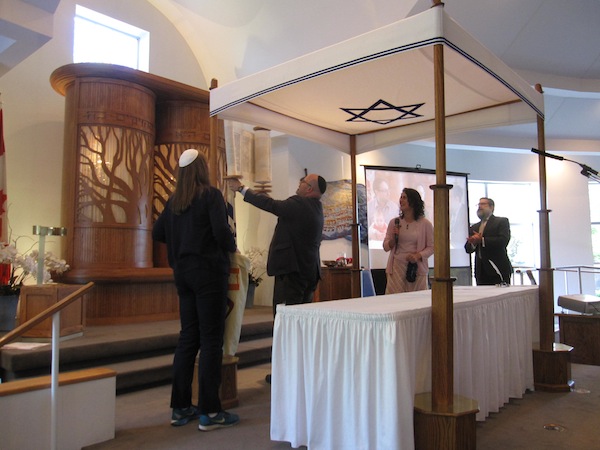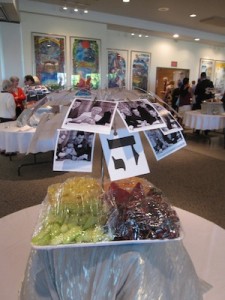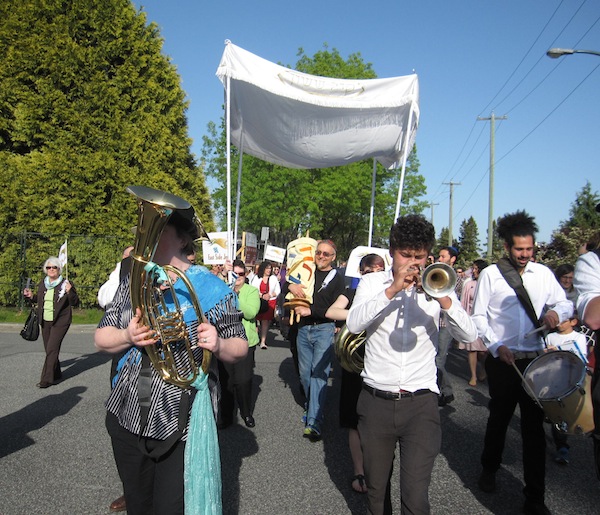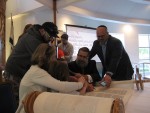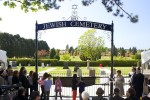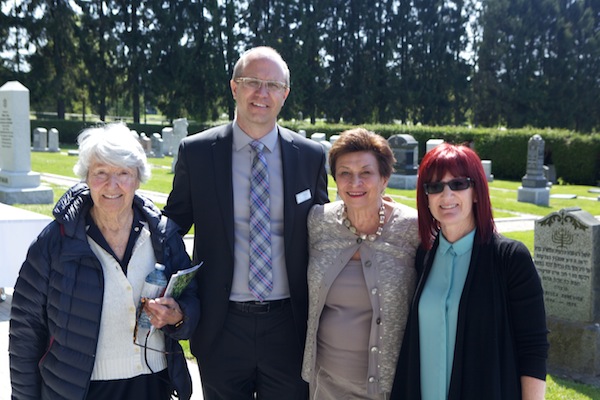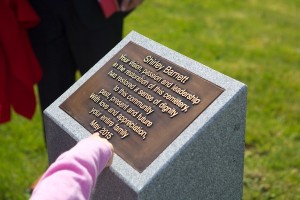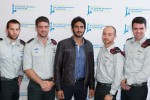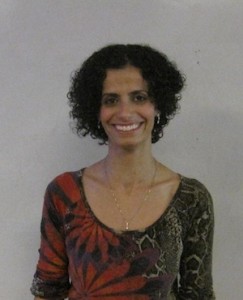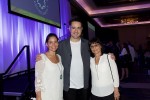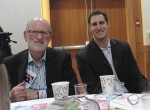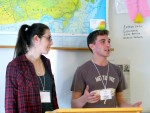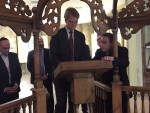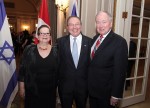Innovators Lunch speaker Brian Scudamore with Kate, left, and her mother, Wendy, who received supportive services from Jewish Family Service Agency in a time of need. (Adele Lewin Photography)
The 2015 Innovators Lunch raised almost $296,000, with more expected. The total was boosted by speaker Brian Scudamore, founder and chief executive officer of 1-800-Got-Junk?, donating back his fee to the Jewish Family Service Agency.
On April 29, 545 people came out to hear Scudamore speak at the Hyatt Regency Vancouver. They also watched a video featuring several people who had been helped by JFSA’s programming and service provision, one of whom, Michael Narvey, addressed the crowd. The audience also heard from JFSA board chair Joel Steinberg, Beth Israel Rabbi Jonathan Infeld, day-of-event co-chairs Megan Laskin and Hillary Cooper and senior management consultant Richard Fruchter. Shay Keil of Keil Investment Group, which was a co-presenting sponsor with Austeville Properties, introduced Scudamore.
Though Scudamore dropped out of high school and out of university, he said, “I love to learn. I love asking questions, meeting people and learning why they are successful, what motivates them and drives them in life. It just happened to be that school did not work for me.”
So, he became an entrepreneur, with a focus on vision, people and systems. He illustrated the importance of these three things in the story of how he became a businessman.
In summer of 1989, he was one course short of high school. Knowing he wasn’t going to complete that course, he talked his way into Langara College, one of the four colleges he would attend briefly. His vision at the time was to go to college and that’s what he did. However, he had to find his own way financially, as his parents weren’t going to fund his studies, given his history: “I don’t think it was a good ROI [return on investment],” he admitted.
While waiting in the line of a McDonald’s drive-through, Scudamore noticed that pickup truck in front of him had the hauler’s phone number on the side. He thought, “What a great idea. I had a thousand dollars in the bank, took 700 of it to go buy a pickup truck of my own.” He spray-painted his number on the side and parked it in different locations around the neighborhood. “Mobile billboards got me business and, within two weeks, I had a business that was humming and making money.”
The experience of building something, his interactions with customers and having fun inspired him to consider business as a future. “My grandparents, my Jewish grandparents … ran a small Army Surplus store in a fairly impoverished area of San Francisco downtown. I used to go down every spring break, summer, Christmas holiday, Chanukah, go work at the store, and I loved it. I loved watching how they treated people. They were the only store on the street that wasn’t robbed once a week. In fact, in their history, they were only robbed twice because I saw that they would give an ear to anyone who came in…. They would never give money, but they would give love, attention and time of day to somebody. They developed a group of friends in the community and the word out on the street was that you just don’t mess with the Lorbers, they’re nice people.
“I learned that business wasn’t just about ringing the cash register and making money. It’s never been that for me, and thank goodness for the influence of my grandparents. For me, business is having fun, bringing people on board and building something special together.”
By 1991, he was at the University of British Columbia. Bored, he made a deal to sell his business, which fell through. This failure taught him “that the low moments precede the highs.” And something good did happen. He grew the business and, in 1992, on the advice of his then girlfriend, he told his business story to the press. The result: a front-page article in the Province. He described it as a “full-sized ad, for free…. I’m going to systematize this and start doing more.” That day, he not only “felt like a rock star,” but he got “100 phone calls in 24 hours.”
In 1993, he finally sat down with his dad to tell him that he was dropping out of university. He incorporated his business, went from one to three trucks and was at about half-million dollars in revenue by 1994.
He had 11 employees but nine of them weren’t the right fit, he said, so he fired them all. He took full responsibility for not being a good leader, for hiring the wrong people. He apologized, and learned from the experience. Among the most important lessons: “it’s all about people.”
He spoke about The EMyth, “the most incredible business book” he’s ever read, which recommends running your business like a franchise even if you don’t plan to make it one. Franchises tend to be more successful, he explained, because they are based on systems of best practices that can be replicated. He followed that direction and, in 1997, hit a million dollars in revenue.
He joined the (Young) Entrepreneur Organization. For him, “it was a way to learn from others, other businesspeople, entrepreneurs that had been successful. I could understand what works and what didn’t, and that filled my thirst for knowledge.” He also actively sought out mentors and people on whom he could rely for advice.
In 1998, he was “bored” and wanted more. He wrote a short list of possibilities, or goals, including “being the FedEx of junk removal,” being “on the Oprah Winfrey Show” – “I envisioned a future that was so crazy, but I started to read it and I’m, like, my craziness actually seems real to me. I could see the vision, the picture in my mind, and I latched on to it and I said I will make this happen – not if, I hope to, want to, will try to, I will make this happen, and I crystal-balled the future.”
At the time he wrote down this vision, he had almost 10 paycheques written to himself that he couldn’t afford to cash, and there were employees who quit over his new direction. Nonetheless, he began to learn about how to franchise. He spoke to many people, he got over hurdle after hurdle, including having to find out who owned the phone number 1-800-Got-Junk and buying it once he did – from the Idaho department of transportation – as he’d already designed the logo with the number. The first franchise was created in 1999 and it made $1 million in the first year, “because we had the systems.”
In the next several years, the focus was on franchising and also on systematizing the media aspect, which had proven so useful before. “Fortune magazine did this three-page feature and we had 506 inquiries in the first week, and I’ll say the first week was Thursday to Sunday.”
He asked his employees what they could imagine with regard to growing the business, with the caveat that they would have to take responsibility for bringing the idea(s) to fruition. The company also works with employees to help them set and accomplish personal goals and, in 2004, 1-800-Got Junk? won British Columbia’s best company to work for contest. They immediately set upon figuring out how they could win it again, not for the sake of winning, but to keep improving the business and the work environment.
At $100 million in sales in 2006, the rollercoaster descended, he said. They dropped $40 million in revenue and he had to fire his best friend – “thankfully he knows it was the right decision.” They were both quick shooters and the business needed a more cautious partner. In the end, the entire leadership team was changed, dozens of people laid off, “partially because of mistakes we made, partially because of the recession. It was awful.” Three and a half years of rebuilding, however, turned things around.
Scudamore has learned to embrace mistakes, to learn from them, and he encourages his employees to do so, as well. “If you’re not making mistakes, if you’re not getting out of your comfort zone and taking risks in life, you’re not living,” he said.
Once he found the right-hand person who best complemented his strengths and weaknesses, Eric Church, the business expanded into other companies, such as Wow 1 Day! Painting and You Move Me. He also expanded personally into other areas, such as becoming involved in Free the Children with his family, thanks to Lorne Segal. He “didn’t have this sense of philanthropic community” when he was a kid, but his daughters, now 10 and 7, believe they “can actually change the world.”
He said, “I believe that we all have a purpose to do something great in our lives and we’ve all got to get to building something, a family, community, charitable organizations and business.… I think, again, it comes down to, ‘It’s all about people.’ Can you inspire people, can you find the right people and treat them right?”
One thing Scudamore loves about community, “is people helping other people.” He concluded, “I don’t know if everybody knows their purpose and what they’re doing. I often believe sometimes you need to be a little crazy to think you can change the world, but I think that we’re all a little crazy, and I know that we can.”
For more on Scudamore, visit 1800gotjunk.com/us_en/about/brian_scudamore.
